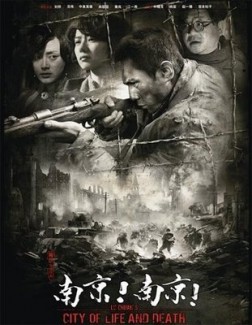City of Life and Death (Chuan Lu, 2009): China/Hong Kong
Reviewed by Lea Encarnacion. Viewed at Mann Chinese Theater 6 in Hollywood during the AFI Film Festival, 2009.

City Of Life And Death (also known as Nanking! Nanking!) is a historical war film set in 1937 that tells the story of the Nanking Massacre in China during which 300,000 Chinese soldiers and civilians were killed by the Japanese Army. The film by award-winning Chinese director Lu Chuan (Kekexili: Mountain Patrol, The Missing Gun) was shot entirely in black and white. It was released in China earlier this year in April and was hugely successful, earning about 20 million dollars in its first two weeks. In this film, the opening battle scenes were the most intense, fast paced and heaviest scenes I have seen all week and I was at the edge of my seat the whole time.
In the first ten minutes of the film, we see the Japanese Imperial Army takeover the city of Nanking, China at the wall where there is an army barricade. The two sides surge forward and begin the battle, with the Chinese side losing slowly. The Japanese soldiers search around the city and find Chinese women, children and wounded soldiers hiding in a church. Since they have orders to kill all Chinese soldiers, they call for reinforcements. The Japanese soldiers separated all the wounded Chinese soldiers from the women and children, dragged them into a dilapidated building and burned it down. Cut to a different scene where we see a family living in a hideout, where the father works for a German diplomat to China and is trying to get papers to flee the country. The Japanese army takes down all the statues and replaces them with the Japanese flag.
After the Japanese Imperial Army take control over the whole city, they force some girls out from the group of women and rape them. This creates fear and tension for the Chinese women who cut all their hair off, with the exception of a few handful who want to keep their long curly hair. The story cuts back to the German diplomat, who tries to negotiate with the Japanese Army to keep his place as a refuge safety zone, but the Japanese only agree in exchange of a hundred “comfort” women. They are raped, killed, and wheeled off dead and naked in a wheelbarrow.
Throughout the whole film we see stories of different figures and characters, both historical and fictional, weaved together through trying to save others or themselves. The ending is not entirely a happy ending for everyone. This film was very moving, emotional, manipulative, intense, and hard to watch. The acting, direction, and sound was all very brilliant and impressive. The film gave an intelligent and sensitive view of the issues of war, terrorism, and oppression against women, and it also had an unbiased view compared to other war films where the story is sometimes told from only one side. I highly recommend this film for its expressive and impressive quality, intensity and purpose in educating people today about the histories of the Second Sino-Japanese War.
About this entry
You’re currently reading “City of Life and Death (Chuan Lu, 2009): China/Hong Kong,” an entry on Student Film Reviews
- Published:
- 11.10.09 / 12am
- Category:
- AFI Filmfest 2009, Films
1 Comment
Jump to comment form | comments rss [?] | trackback uri [?]